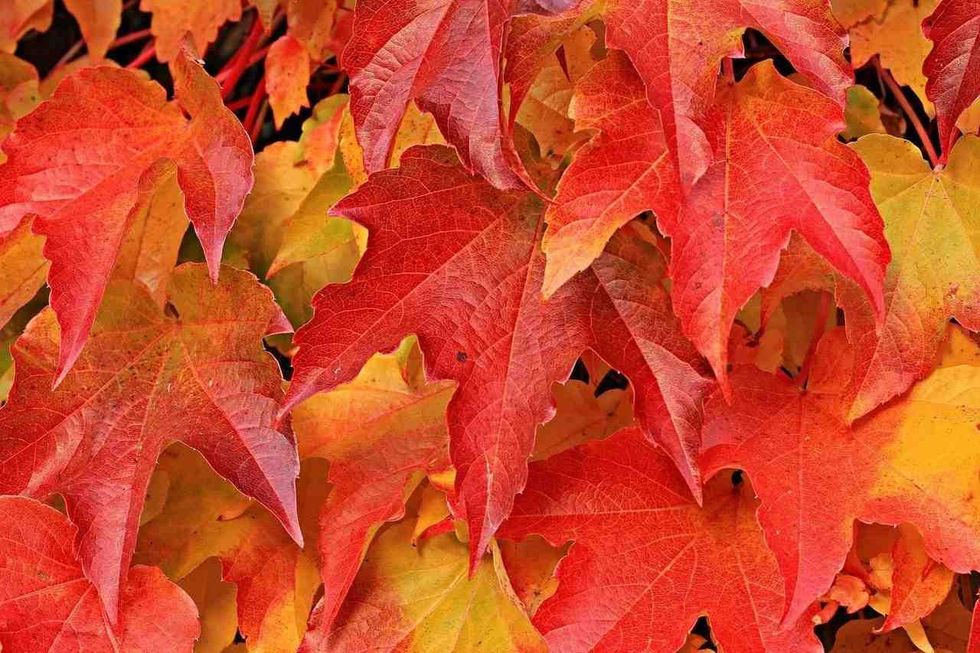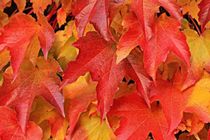Have You Ever Seen A Tree With Star-Shaped Leaves? Have A Look At It

Every leaf has its own unique features that may be used to learn more about its tree.
In general, we gather various sorts of leaves as youngsters and save them as a wonderful treasure. Have you done it?
Collecting leaves or seeds even from lofty trees may not be a challenging activity when you appreciate nature. Aside from our curiosity, many plant biologists, naturalists, geneticists, and foresters collect them as part of their study.
This effort, on the other hand, never bores anyone. It is stated that every falling leaf contains both agony and beauty, and that is how new leaves develop.
Today as we continue our quest of exploring new types of leaves, let us learn more about a star-shaped leaf. Yes, you read that correctly: a leaf in the shape of a star.
However, before we begin, to learn more about trees, we request you read our other articles about what is a tree and types of trees.
How To Grow A Tree With Star-Shaped Leaves
Leaves come in a variety of forms, shapes, and textures. Some are thin, while others are broad, and some are pretty tough; we can readily estimate the tree from its leaf.
The tree that has a star-shaped leaf is called the sweetgum tree. Its botanical name is Liquidambar styraciflua.
It is known with many names like star-leaved gum, redgum, hazel pine, satin-walnut, American storax, or just referred to as sweetgum. These are the only flowering plant from the family Altingiaceae was previously classified as Hamamelidaceae. Both of its botanical and popular names are taken from the resin or liquid amber that the trunk exudes when it is cut.
It consists of 15 different species. Sweetgum is a tall growing tree with cylindrical root systems, distinctive leaves, and vibrant autumn fall colors.
These trees can be seen in forests across their native North American region and can be grown as ornamental trees in many other temperate zones of Mexico and Central America. It is also found in Southeastern and East Asia, western Mediterranean regions.
Follow these steps if you want to raise a sweet gum tree in your garden. Remember, these sweetgum trees primarily need moist, acidic clay loam soil.
Firstly collect softer fruits in autumn to get seeds from them, which are solid brown in color and not yet opened. Now let the fruits dry for about one week in a cold, dry environment.
Once these softer fruits turn hard and open, you can collect up to 50 tiny seeds per fruit. Carefully choose a suitable one from tiny seeds to transplant and discard the damaged seeds.
Prepare a nursery tray with a mix of three parts milled peat, one part loam soil, and one part coarse sand. Before adding peat, you need to soak peat in water and drain it after 20 minutes.
Once the tray is ready, you can plant the sweetgum seeds inside the mixture. You can even scatter a light layer of the sand mixture over the seeds.
Now sprinkle with little water over the sand. Now place this tray in partial sunlight and water these seeds regularly.
Seeds get germination in 20-30 days. Continue to grow them in a nursery tray until they are healthy enough to move into your garden.
You need to plant each seedling with 25 ft (7.62 m) spacing and where there is full sunlight or partial shade. Once you transfer them to the ground, you can water them occasionally or only if the climate is dry for more than two weeks.
Moreover, please note that they have a moderate salinity tolerance. Sweetgum can develop chlorosis in alkaline soils, specifically when organic material levels are too low. Chlorosis is a situation of yellowing leaf tissue due to a lack of chlorophyll.
Also, we need to note that the Sweetgum tree does not thrive in shaded places. Sweetgum trees require regular watering and maintenance until they are well-established, and once these trees mature, they tolerate occasional drought as well as periodic flooding. Mature Sweetgum trees need very little care.
Before planting these sweetgum trees, you need to note that they need a large area as they have vast root growth. Moreover, they are sensitive and cannot tolerate pollution.
Features
Sweetgum trees make an excellent shade tree and are ideally suited for planting in prominent places with full sunlight, such as a lawn or park. The American sweetgum tree is a popular shade tree and forest tree among them in the natural range as they are massive with the pyramidal crown.
Let us now learn its features to understand them better.
These Sweetgum trees are medium to large trees, can grow up to from 82–131 ft (25–40 m), and sometimes in the wild, they can grow up to 150 ft (45 m). The Sweetgum tree grows straight and has short branches and twigs.
Young trees rise in a pyramidal shape, becoming more oval or rounded as the tree matures. Sweetgum tree has corky bark which is a light brown shade with red and gray with black dots.
It also holds deep fissures, rounded ridges, and scaly textures. The branches are short attachment and coated with rusty hairs initially, ultimately becoming red-brown, dark brown, or gray.
These Sweetgum trees are easily identified by their five-pointed star shape leaves, which are similar to maple leaves. Sweetgum tree has green leaves that are five deeply pointed palmate lobes just like fingers on a hand symbolizing a star-shaped.
These green leaves give a nice aroma when crushed. Sweetgum trees generally have green leaves deeply lobed; however, they turn a different color in the fall.
Another distinctive feature of the Sweetgum tree is fruit is its spiky ball. This fruit consists of 60 tiny capsules. Again, each capsule contains two small, winged seeds with spikes that appear as a spiky ball. These fruits are also known as burr balls, spike balls, space bugs, gumballs, or sticker balls.
The sweetgum trees are monoecious; thus, both pistillate flowers (male) and staminate flowers (female) individually rise on the same tree. Hence single flower doesn't have both pistil and stamen.
Male flowers are evolved as racemes, which resemble green pyramids comprised of balls of green stamens, while female flowers appear grouped in a spherical group or as a cluster of flowers. These flowers are usually seen on elevated branches.
Male flowers rise above the leaves, while female flowers hang beneath them. Male flowers fall down, and female flowers typically remain on the tree, having unique tube sections with sticky edges to capture pollen carried by the wind.
The female structure dries into what is widely referred to as Gumballs. Sweetgum trees do not flower until they are 20-30 years old.
Let's have a look at some sweetgum species.
The American sweetgum tree is the most well-known of all sweet gum trees. The American sweetgum is a great shade tree with a tall, straight trunk with deeply ridged bark, and it has short branches and twigs forming a broad conical crown.
This American sweetgum tree has shiny dark green and aromatic leaves and spherical gumballs. Its leafless branch quickly visualizes a reptile impression; hence the tree is often referred to as alligator wood.
This American sweetgum tree grows in USDA farming zones five to nine. Do you know that these trees can survive for up to 400 years?
American sweetgum tree has many cultivars that are granted from the Royal Horticultural Society's Award of Garden Merit.
Burgundy has been a popular choice in yards since this has deep dark red that turns to purple in autumn. The next cultivator is Clydesform.
This is suitable for wet areas that slowly grow into a narrow pyramidal up to 29.5 ft (9 m); its leaves turn into purple, yellow, or orange colors in the fall and last more prolonged than any other cultivars. It is also known as Emerald Sentinel.
Festival is a columnar tree with pale green leaves that turn into bright yellow, pink, and red in autumn.
The next cultivar is Firehouse which has a striking red fall color that defoliates early and yields little to no seed. Gumball is a dwarf shrubby cultivar that is only 6.5 ft (2 m) tall, with purple-red fall color.
Rotundiloba has rounded lobes on leaves and yields no fruit, initially found in North Carolina in the '30s. Other cultivars are Goduzam or Gold Dust, Lane Roberts, Moraine Grazam, Worplesdon, Palo Alto, Parasol and Pen wood.
Next is the slender silhouette sweetgum, which grows in USDA zones five to eight. The sweetgum slender silhouette is ideal for tiny gardens, confined places, or a stunning vertical accent because of its tall and thin build.
While American sweetgums are regarded as a hassle because of the fruit fall, these slender silhouette sweetgums only produce a small quantity of fruit and cover only a small area. Slender silhouette sweetgums' shiny green lobed leaves turn lovely red and orange colors in the fall.
Chang's sweetgum is a species found mostly in southern China. It is a medium-sized deciduous tree with three-lobed leaves that turn red before falling in autumn.
The cultivar burgundy flush from this species has even won The Royal Horticultural Society's Award of Garden Merit as leaves that open purple color, then to green color, later into burgundy red color in fall.
Next, is Liquidambar cambodiana, widely termed Sdey, a sweetgum tree native to southwest Cambodia. This tree grows to a height of 26.24 -32.8 ft (8 to 10 m).
The species is distinguished from other sweetgum trees by a shiny top surface of the leaves, and edges are rolled downwards when they are dried. Except for three areas in the Dâmrei Mountains in southern Cambodia, these sweetgum plants have not been spotted in a few decades.
Liquidambar formosana, usually known as Formosan gum or Taiwanese sweet gum, is an East Asian native sweetgum tree species. These sweetgum trees are enormous and may reach 98.42-131.23 ft (30-40 m). Their leaves are three-lobed and, in fall, become a beautiful red. The leaves are simple, palmately-veins with serrated edges and grow alternatively pattern.
Successive in the list is Liquidambar Orientalis, often known as Turkish sweetgum or Oriental sweetgum. This tree species is native to the eastern Mediterranean area, mainly in Turkey and on the Rhodes islands of Greece.
This oriental sweet gum grows to an elevation of 98–115 ft (30–35 m), and its trunk has a diameter of 39 in (100 cm).
The tree thrives in rich, moist soils such as lakes, riverbanks, and seashores. These species have been specially preserved on 710 acres (286 ha) in Mula between Dalyan and Köyceiz since they play a vital role in the local economy of Greece and Turkey by producing a variety of goods.
Season
The conditions change with the seasons. Each season marks a new beginning in the plants. Seasonal changes in sweet gum trees are significant. Let us explore how the season impacts them.
Sweetgum tree is popularly cultivated as ornamental and forest tree for its great leafage and splendid autumn colors. As the season changes, the rich dark green leaves naturally change to bright red, orange, purple, and yellow. The most attractive part of this sweetgum tree is that it changes all of these distinct hues of leaves on the same tree.
Generally, American sweetgum trees' red and yellow leaves resemble maple leaves; and its dark purples and smoky browns of the ash. However, sweetgum tree leaves are easily recognized from other leaves by their shiny, leathery leaves and positioned individually on alternative sides of the stems, whereas others are opposite sides.
It is also observed that early spring leaves are smaller with shallow lobes, while in midsummer, leaves grow bigger with have deeper lobes, and late-season leaves are small but hold the deepest lobes. This pattern represents that the Sweet-gum tree continuously grows all season, extending branches and adding leaves until a cool climate.
One of the most distinguishing features, particularly in the northern part of the habitat, is that the bark on the twigs and branches of some trees attaches by edges rather than its wide surfaces, giving it a winged appearance.

Facts About Tree With Star Shaped Leaves
As you love watching sweetgum leaves fall and fill the streets, or your lawn with gorgeous colors may be a nature's treat for your soul.
But apart from being beautiful trees, sweetgum trees have a range of uses that you should be aware of, so let us look at some interesting facts about sweetgum trees to learn more about them.
The wood from the sweetgum tree is strong and long-lasting, with a uniform grain pattern. More aged trees and a few younger sweet-gum trees possess broad central wood, known as red gum, in the marketplace.
This wood has diverse and multiple shades of reddish-brown. Sweetgum tree wood that is multicolored with darker streaks is called figured red gum.
Since wood is interlaced grain, it generates ribbon strips when quartersawn, making it more dimensionally stable and ideal for working.
As a result, the sweetgum tree is good for making various types of furniture, interior decoration, electronic cabinets, railroad ties, barrels, cigar packs, chopsticks, baskets, crates, and much other woodenware. It also gets lovely gloss; hence it is also used on doors or panels for an aesthetic look.
When this sweet gum tree is injured, the gummy sap is discharged from the bark, also called liquid amber or copalm balsam. This natural sap or resin is an aromatic gum identical to turpentine.
It is a waxy substance that is transparent, red, or yellowish in color. This gummy resin hardens as it matures, and this is the state in which it is usually transported in barrels.
The resin is made by peeling, boiling, and squeezing the bark of a sweetgum tree. This gum is used medicinally as well as to manufacture chewing gum.
Shikimic acid is extracted from the sweetgum seeds, which is used in the pharmaceutical sector to make an antiviral drug used to cure and prevent influenza A and influenza B viruses.
Oriental sweet gum or Turkish sweetgum produces essential oils known as storax or styrax obtained from its sap possesses several therapeutic benefits, which are further diluted with an appropriate carrier oil and utilized as an external application in traditional medicine.
This Taiwanese sweetgum tree is extensively used in many medical applications; its leaves and roots have been proved to cure cancer cells. The bark of the stem is utilized to heal skin disorders and diarrhea.
The fruits of this sweetgum tree are used to cure arthritis, urinary problems, extreme back pains, swelling in the body, skin disorders, and low milk supply. The aromatic resin extracted from the branches is used to cure tuberculosis, severe wounds, toothaches, blood circulation, and relieve pain.
Sweetgum sap also covers its bark wounds and, when hardened, forms a protective coat on the tree. Because it is sticky and scented, it may also keep digging insects away.
It is observed that Eastern goldfinches, sparrows, mourning doves, northern bobwhites, wild turkeys, and purple finch consume the seeds of the American sweetgum. While red and grey squirrels and chipmunks like the fruits and seeds as well. Moreover, caterpillars of the Luna and Promethea moths feed on the leaves.
Besides, these sweetgum trees have colorful foliage, release spiky gumballs, and spread quickly throughout the garden. It's reasonable to wish to restrict their expansion because they swiftly take up territory.
To kill sweetgum, you need to spray it with an Arsenal chemical. Based on the tree size, you cut the tree and inject them, or if the trees are tiny, this herbicide needs to be sprayed over the top.
Here at Kidadl, we have carefully created lots of interesting family-friendly facts for everyone to enjoy! If you liked our suggestions for, have you ever seen a tree with star-shaped leaves? Have a look at it, then why not take a look at all about trees or types of oak trees in Georgia.
We Want Your Photos!
More for You
See All
Bachelor of Science specializing in Botany, Master of Science specializing in Clinical Research and Regulatory Affairs

Sridevi ToletyBachelor of Science specializing in Botany, Master of Science specializing in Clinical Research and Regulatory Affairs
With a Master's degree in clinical research from Manipal University and a PG Diploma in journalism from Bharatiya Vidya Bhavan, Sridevi has cultivated her passion for writing across various domains. She has authored a wide range of articles, blogs, travelogues, creative content, and short stories that have been published in leading magazines, newspapers, and websites. Sridevi is fluent in four languages and enjoys spending her spare time with loved ones. Her hobbies include reading, traveling, cooking, painting, and listening to music.
Bachelor of Arts specializing in English Literature

Nishtha DixitBachelor of Arts specializing in English Literature
Nishtha is an experienced SEO writer and editor, with a passion for writing and self-expression. She is currently pursuing an undergraduate major in Literature and Communication and a minor in Political Science from the University of Delhi. Nishtha has completed a certificate master course in English from the British Council and has been appointed as the editor for the bi-monthly magazine of the University of Delhi.
Disclaimer
1) Kidadl is independent and to make our service free to you the reader we are supported by advertising. We hope you love our recommendations for products and services! What we suggest is selected independently by the Kidadl team. If you purchase using the Buy Now button we may earn a small commission. This does not influence our choices. Prices are correct and items are available at the time the article was published but we cannot guarantee that on the time of reading. Please note that Kidadl is a participant in the Amazon Services LLC Associates Program, an affiliate advertising program designed to provide a means for sites to earn advertising fees by advertising and linking to Amazon. We also link to other websites, but are not responsible for their content.
2) At Kidadl, we strive to recommend the very best activities and events. We will always aim to give you accurate information at the date of publication - however, information does change, so it’s important you do your own research, double-check and make the decision that is right for your family. We recognise that not all activities and ideas are appropriate for all children and families or in all circumstances. Our recommended activities are based on age but these are a guide. We recommend that these ideas are used as inspiration, that ideas are undertaken with appropriate adult supervision, and that each adult uses their own discretion and knowledge of their children to consider the safety and suitability. Kidadl cannot accept liability for the execution of these ideas, and parental supervision is advised at all times, as safety is paramount. Anyone using the information provided by Kidadl does so at their own risk and we can not accept liability if things go wrong.
3) Because we are an educational resource, we have quotes and facts about a range of historical and modern figures. We do not endorse the actions of or rhetoric of all the people included in these collections, but we think they are important for growing minds to learn about under the guidance of parents or guardians.







